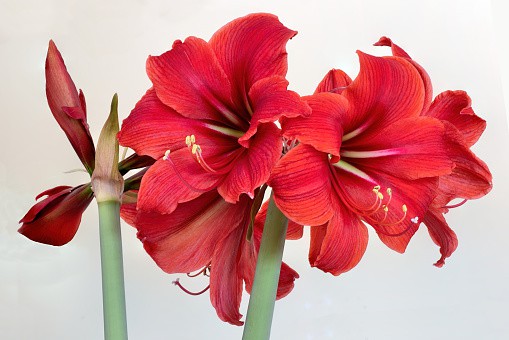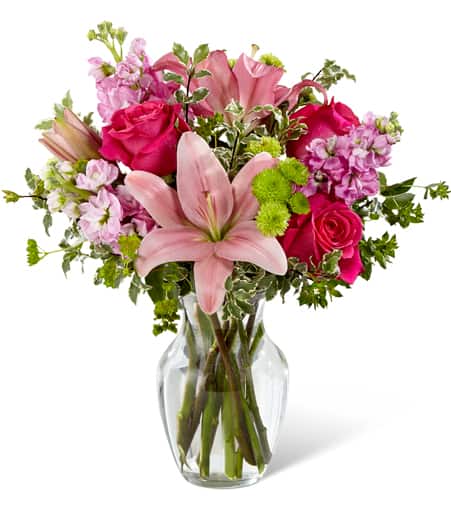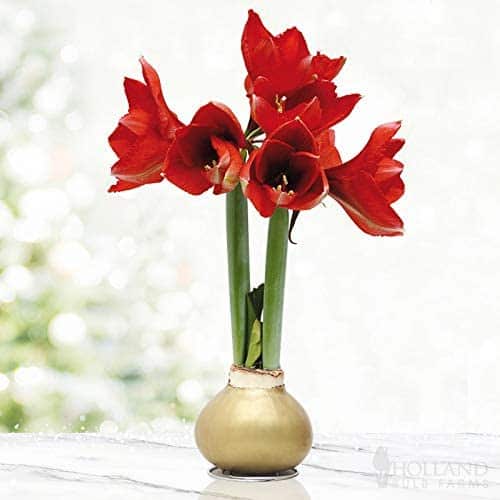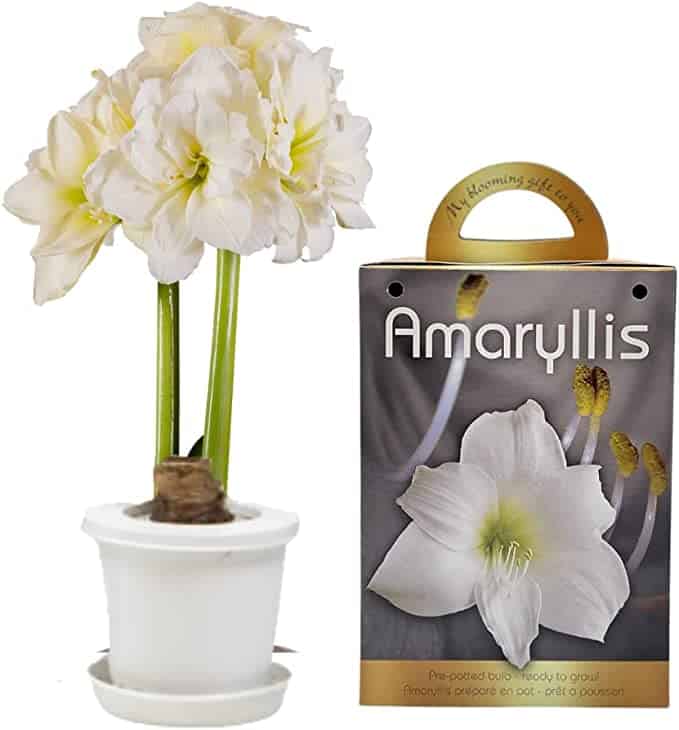Amaryllis | Hippeastrum is a gorgeous flowering plant renowned for its stunning blooms in a variety of colors and shapes. Whether you’re an avid gardener or new to the hobby, learning about the care and growth of Amaryllis can help you cultivate a beautiful and thriving plant.
Etymology
The Amaryllis Flower is taken from an adapted version of the Greek word “Amarysso” which means “to sparkle”. The Hippeastrum genus contains around 90 species which are mainly found in tropical and subtropical regions of Central and South America. The genus name means “horseman’s star”, referring to the shape of the flower.
Buy this flowers bouquet on FloristOne>>
How to Plant
Amaryllis and Hippeastrum are both popular potted plants that beautify homes and gardens. The bare bulb of both Amaryllis and Hippeastrum should be planted in a well-draining, rich potting soil in a container with drainage holes. Amaryllis bulbs generally require about 6-8 weeks of chill time in an area where temperatures between 45°F and 50°F are maintained in order for them to flower. After the chill time, the bulbs should be brought to 55° to 70°F. When the chill time is over, the bulbs can be potted in mid-December so that they flower in time for the Christmas Holiday. When potted, approximately one-third of the bulb should remain above the soil line with the pointy end facing up.
Hippeastrum also requires a chill period. The bulbs should be potted in November in areas with mild climates. They can be potted up to six weeks after the chill period or when sprouts begin to emerge from the bulbs in areas with cooler climates. Choose a container with drainage holes, adding clay pellets or stones to the bottom before potting the Hippeastrum. Place the bulb in the container so that one-third of it remains above the soil. Put the potted bulb in a warm, sunny room and place it near a humidifier as it grows.
Amaryllis and Hippeastrum should be kept in a warm area that receives indirect sunlight. When the flowers start to appear, rotate the pot once every few days to ensure even floral development. Keep the soil lightly moist but not soggy. Feed the plants with a diluted liquid fertilizer once the flower buds have formed.
Meaning and Symbolism
The Amaryllis flower is known for its strong resemblance to the human heart. It symbolizes a strong, eternal and loyal love, as well as courage, strength, and determination. It is also associated with several of the most cherished aspects of life, including faith, beauty, and ambition. The Hippeastrum stands for success, prosperity and splendor.
Buy this pre-potted Amaryllis on Amazon>>
History, Mythology, and Religious Significance
The Amaryllis flower has a long history and is mentioned in ancient Greek mythology. The flower’s name is derived from the desperate love story of Amaryllis. Amaryllis was a shy nymph who fell deeply in love with a shepherd named Alteo. Determined to win his heart, Amaryllis did the impossible task of piercing her own heart with a golden arrow every day for thirty days. Finally, the shepherd was so touched that he returned her love and from those drops of her blood, a beautiful Amaryllis flower blossomed.
The Hippeastrum is an important flower in both Hindu and Catholic religion.
In Hinduism, the flower signifies love, fertility and courage.
While in the Catholic religion, Hippeastrum is associated with the Virgin Mary, which symbolizes purity and innocence. Due to its strong association with religion, the flower is often used to decorate homes and churches during special occasions.
Flower Varieties and their Defining Characteristics
Amaryllis is a popular bulb and there are five types of Amaryllis; large flowering, double flowering, small flowering, cybister, and trumpet. The most popular is the large flowering, single flower Amaryllis, which grows up to 10 inches tall. The bigger the bulb, the more stems and flowers they produce. Some of the more popular variety of Amaryllis include Amaryllis Clown, Red Lion, White Christmas and Carnival.
Hippeastrum comprises of around 90 species and there are a huge range of varieties available. The varieties can be divided into three general categories; single flowered, multi-flowered, and striped. Some of the more popular varieties of Hippeastrum are Amaryllis, Apollo, Derby, Etna, Lucia and Red Emperor. The flowers of Hippeastrum vary in size and shape, with some varieties having large single blooms of up to 8 or 9 inches, while multiflowering varieties have flowers that can range from two inches in diameter up to four inches.
Buy Amaryllis bulbs on Amazon>>
How to Pot and Repot
Amaryllis bulbs should be repotted every two to three years, and before planting the bulb, it should be checked for any signs of damage and decay. When choosing a pot for repotting, the size should be one to two inches larger than that of the old pot. Fill the pot with a mixture of potting soil and pebbles, leaving about one-third of the bulb above the soil line. Keep the soil slightly moist and water lightly when the plant’s foliage begins to appear.
Hippeastrum bulbs should also be repotted every few years. When the bulb sprouts, you can repot the Hippeastrum in either a clay or plastic pot with drainage holes. The pot should not be too large, as it needs to hold enough soil to allow the bulb to settle and grow properly. Fill the pot halfway with a light potting mix and place the bulb in the center and fill with the remainder of the soil, ensuring that one-third of the bulb is exposed. Water the bulb after planting and place the pot in a window with bright, filtered light.
Buy this pre-potted Amaryllis on Amazon>>
How to Prune
Amaryllis and Hippeastrum should be pruned after flowering. Prune the leaves, stems and flower finishes off at the base with sharp scissors. Pruning will help keep the plant healthy by encouraging new growth and removing any dead or dying material. Cut off the entire stem no more than an inch above the base of the bulb for Amaryllis and about four inches above the bulb for Hippeastrum. Prune the foliage of both Amaryllis and Hippeastrum is pruned by cutting back the foliage to the first set of healthy leaves.
How to Propagate
Propagating Amaryllis and Hippeastrum is easy and can be done either through seeds or offsets. Seeds can be collected from the parent plant and planted as soon as they are ripe. You can also separate the offsets from the original bulb and pot them individually.
Common Pests and Diseases
Common pests and diseases that can affect Amaryllis and Hippeastrum include aphids, thrips, and spider mites. To protect the plants from these pests, it is important to keep the foliage dry and many of these pests can be controlled using insecticidal sprays. Botrytis, root rot and scale can also be a problem and can be controlled by good hygiene and pest monitoring practices.
3 Frequently Asked Questions about Hippeastrum
Q1. How do I know when to plant Hippeastrum?
A1. Hippeastrum should be planted around November in areas with mild climates, while they can be planted up to six weeks after the chill period or when sprouts begin to emerge from the bulbs in areas with cooler climates.
Q2. How often should I repot Hippeastrum?
A2. Hippeastrum bulbs should be repotted every few years.
Q3. Is it okay to prune Hippeastrum?
A3. Yes, Hippeastrum should be pruned after flowering by cutting off the entire stem no more than four inches above the bulb.
Table Fact Sheet
| Amaryllis | Hippeastrum |
|---|---|
| Family: | Amaryllidaceae |
| Plant Type: | Perennial |
| Mature Size: | 30 cm (12 inches) tall |
| Sun Exposure: | Bright Light |
| Soil Type: | Well-draining, rich potting soil |
| Soil pH: | 6.5 – 7 |
| Bloom Time: | December – May |
| Flower Color: | Pink, Red, White and other colors |
| Hardiness Zones: | 9-11 (USDA) |
| Native Area: | South America |
What we love from Amazon this week
Buy these wonderful flowers directly from Amazon:



















